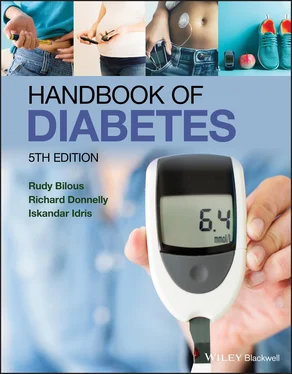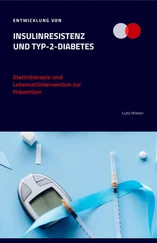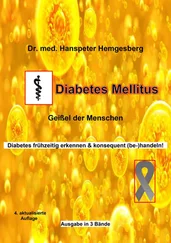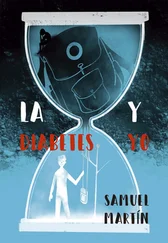The genetics of type 1 diabetes are obviously complex and polygenic. The interaction with environmental factors (see below) which results in an orchestrated T cell mediated and B cell facilitated autoimmune destruction of β cells is likely mediated by a range of different mechanisms, some of which will be more prominent in different individuals, and some of which will operate in sequence or together at different stages in the evolution of type 1 diabetes. It is also worth noting that the majority of those who carry genetic polymorphisms that predispose them to developing type 1 diabetes never do so.
Environmental and maternal factors
Although genetic factors are undoubtedly important, the rapidly increasing incidence rates for type 1 diabetes at a younger age strongly suggest that external or environmental factors are playing a part. Much of the evidence that links environmental factors with the aetiology of type 1 diabetes is circumstantial and associative, based upon epidemiology and animal research. The factors most often implicated are viruses, and diet and toxins, but a number of other influences, such as early feeding with cow’s milk have been investigated ( Table 6.3). These associations remain unexplained but may add support to the hygiene and accelerator hypotheses (see below).
The viruses that have been implicated in the development of human diabetes have been deduced from temporal and geographical associations with a known infection. For example, mumps can cause pancreatitis and occasionally precedes the development of type 1 diabetes in children. Intrauterine rubella infection induces diabetes in up to 20% of affected children. However, the strongest associations have been with enteroviruses. A meta‐analysis of 26 studies found an OR of 3.7 (95% CI 2.1, 6.8) for enterovirus serological positivity in patients with islet cell autoantibodies and symptomatic type 1 diabetes, and the virus most commonly identified is coxsackie B. There was, however, a significant heterogeneity in these studies. In prospective cohort studies, patients with positive enterovirus antibodies had accelerated progression to symptomatic diabetes, but they did not seem to initiate islet autoimmunity.
Table 6.3 Associated foetal, maternal, dietary and environmental factors with the strength of the relationship (where known) on the development of type 1 diabetes (T1DM).
| Associated factor |
Strength of relationship |
| Shorter gestation |
RR 1.18 (95%CI 1.09, 1.28) for gestational age 33–36 weeks and 1.12 (95% CI 1.07, 1.17) for 37 & 38 weeks |
| Birth weight |
SGA RR 0.83 (95% CI 0.75, 0.93) LGA RR 1.14 (95% CI 1.04, 1.24) Severe SGA reduced risk for T1DM |
| Greater linear growth |
Children diagnosed aged 5–10 years taller than peers but growth may be slowed with T1DM onset around puberty |
| Maternal age |
5–10% increase odds per 5 year increase in maternal age |
| ABO blood group incompatability |
Frequency of HLA DR3 similar in children with ABO incompatability and those with T1DM. OR 2.7 compared to controls |
| Birth order |
Weak evidence that 2 ndor later child are less likely to develop T1DM < 5 yrs of age |
| Delivery by caesarean section |
Adjusted OR 1.19 (95% CI 1.04, 1.36) |
| Breast feeding (bf) |
OR 0.75 (95% CI 0.64, 0.88) for 2 weeks bf; weaker for 3 months. No benefit of non‐exclusive bf beyond 2 weeks |
| Dietary cereals |
Later exposure (>7 months) to gluten HR for T1DM 3.33(95% CI 1.54, 7.18). Early exposure (<3 months) increases risk of coeliac disease. |
| Vitamin D supplements |
OR 0.71 (95% CI 0.60, 0.84) but marked heterogeneity in studies |
| Omega 3 fatty acids |
Lower intake associated with higher rates in Norway. Clinical trials underway |
| Atopy |
OR 0.82 (95% CI 0.68, 0.99) for asthma in children with T1DM, but not eczema or rhinitis (see hygiene hypothesis) |
| Child day care |
Inconclusive data but some association between attending day care and lower T1DM risk |
OR = odds ratio; RR = relative risk; HR = hazard ratio; CI = confidence interval; SGA = small for gestational age; LGA = large for gestational age.
In a few cases, coxsackie viral antigens have been isolated in islets postmortem, and viruses isolated from the pancreas have been shown to induce diabetes in susceptible mouse strains. Electron microscopy of the pancreas in some subjects who died shortly after the onset of type 1 diabetes identified retrovirus‐like particles within the β cells, associated with insulitis. There have also been case reports of multiple family members developing type 1 diabetes after contracting enteroviral infection.
Viruses may target the β cells and destroy them directly through a cytolytic effect or by triggering an autoimmune attack ( Figure 6.7). Autoimmune mechanisms may include ‘molecular mimicry’; that is, immune responses against a viral antigen that cross‐react with a β cell antigen (e.g. a coxsackie B4 protein (P2–C) has sequence homology with GAD, an established autoantigen in the β cell). Also, anti‐insulin antibodies from patients with type 1 diabetes cross‐react with the retroviral p73 antigen in about 75% of cases. Alternatively, viral damage may release sequestered islet antigens and thus restimulate resting autoreactive T cells, previously sensitised against β cell antigens (‘bystander activation’). Persistent viral infection could also stimulate interferon‐α synthesis and hyperexpression of HLA class I antigens, and the secretion of chemokines that recruit activated macrophages and cytotoxic T cells.
One model of β cell destruction is via the process of apoptosis or programmed cell death ( Figure 6.8). This is effected by the activation of cellular caspases triggered by extrinsic means, including the interaction of cell surface Fas (the death‐signalling molecule) with its ligand FasL, on the surface of infiltrating CD4 and CD8 cells. There is an intrinsic pathway mediated by a balance between anti‐ and pro‐apoptotic mitochondrial pathways and both converge via the caspase activation pathway to cause β cell death. Other factors that induce apoptosis include macrophage derived nitric oxide (NO) and toxic free radicals, and disruption of the cell membrane by perforin and granzyme B produced by cytotoxic T cells. T cell cytokines (e.g. interleukin–1, tumour necrosis factor–α, interferon–γ) have been shown to up‐regulate Fas and FasL and induce NO and toxic free radicals.
Wheat gluten is a potent diabetogen in animal models of type 1 diabetes (BB rats and NOD mice; see below), and 5–10% of patients with type 1 diabetes have gluten‐sensitive enteropathy (coeliac disease). Recent studies have demonstrated that patients with type 1 diabetes and coeliac disease share disease‐specific alleles. Wheat may induce subclinical gut inflammation and enhanced gut permeability to lumen antigens in some patients with type 1 diabetes, which may lead to a breakdown in tolerance for dietary proteins. Other possible diabetogenic factors in diet include N–nitroso compounds, speculatively implicated in Icelandic smoked meat, which was a common dietary constituent in winter months.
The notion that there may be environmental β cell toxins is supported by the existence of chemicals that cause an insulin‐dependent type of diabetes in animals. Examples are alloxan and streptozocin, both of which damage the β cell at several sites, including membrane disruption, enzyme interaction (e.g. with glucokinase) and DNA fragmentation. The rat poison vacor causes type 1 diabetes in humans, possibly because it has a similar action to streptozocin.
Читать дальше












